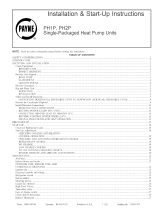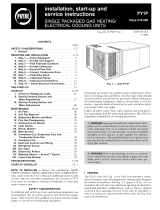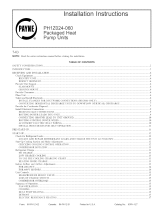
ELECTRIC HEAT OR EMERGENCY HEAT MODE
Thermostat closes R to W. W energizes electric heat relay(s) which completes circuit to heater element(s). Blower motor is energized through
nonnally closed contacts on fan relay. When W is de-energized, electric heat relay(s) opens turning off heater elements. Blower motor is
de-energized after heater relay(s) opens.
B. PF1MNB071 Fan Coil Sequence of Operation
CONTINUOUS FAN
Thermostat closes circuit R to G. The blower runs at continuous fan airflow.
COOLING MODE
Thermostat closes circuits R to Y/Y2, R to O, and R to G. Fan coil delivers single-speed cooling airflow.
ELECTRIC HEAT HEATING MODE
Thermostat closes circuit R to W_W1, 02"W2. Fan coil delivers the selected electric heat airflow.
HEAT PUMP HEATING MODE
Thermostat closes circuit R to Y/Y2, and R to G. Fan coil delivers single-speed heat pump heating airflow.
HEAT PUMP HEATING WITH AUXILIARY ELECTRIC HEAT
Thermostat closes circuits R to Y_Y2 and.or R to Y1 with R to W_W1 or W2 (and R to O in the case of defrost). In the event that electric heating
is called for by thermostat while heat pump is also operating in either heating or defrost mode, the motor will modify its airflow output, if necessary,
to provide an airflow which is defined as sate for operation of electric heater during heat pump operation. That airflow is the greater of the heat
pump heating airflow and the electric heater only airflow.
START-UP
Refer to outdoor unit Installation Instructions for system start-up instructions and refrigerant charging method details.
PROCEDURE 1--EASY SELECT CONFIGURATION TAPS (SIZE 071 ONLY)
The EASY SELECT taps are used by the installer to configure a system. The ECM uses the selected taps to modify its operation to a
pre-programmed table of airflows. Airflows are based on system size or mode of operation and those airflows are modified in response to other
inputs such as the need for de-humidification. (See Fig. 21.)
The fan coil nmst be configured to operate properly with system components with which it is installed. To successfully configure a basic system
(see infonnation printed on circuit board label located next to select pins), move the 6 select wires to the pins which match the components used.
A. AUXILIARY HEAT KW/CFM -- Select heater range for size of electric heater installed
Installer nmst select the auxiliary heat airflow approved for application with kw size heater installed. If no heater is installed, this step can be
skipped. Each select pin is marked with a range of heaters for which airflow, also marked, is approved. For increased comfort select the nan'owest
kw range matching the heater size, for example, 0-10 for 10-kw heater. This airflow must be greater than the minimum CFM for electric heater
application with the size system installed for safe and continuous operation. (See Tables 1 and 2 for airflow delivery and minimum CFM.) Note
that airflow marked is the airflow which will be supplied in emergency heat mode and heating mode on air conditioners when electric heat is the
primary heating source. In heat pump heating mode when electric heaters are energized, the ECM will run the higher of heat pump heating airflow
and electric heater airflow to ensure safe heater operation. The factory selection is the largest heater range approved. (See Fig. 21, A as indicated.)
B. AC/HP SIZE -- Select system size installed
The _actory setting for air conditioner 02"heat pump size is the largest unit meant for application with the model of_an coil purchased. The installer
needs to select the air conditioner or heat pump size to ensure that airflow delivered falls within proper range lbr the size unit installed. This applies
to all operational modes with the exception of electric heat modes. (See Fig. 21, B as indicated.)
C. SYSTEM TYPE -- Select system type installed AC or HP
The type of system nmst be selected:
1. AC Air conditioner
2. HP-COMFORT Provides approximately 315 CFMiton for higher normal heating air delivery temperature. Provides approximately 350
CFMiton cooling airflow for good humidity removal.
3. HP-EFF Heat Pump Efficiency provides same airflow for heating and cooling modes to increase overall HP efficiency; approximately
350 CFMiton.
The factory setting is AC. (See Fig. 21, (7 as indicated.)
D. AC/HP CFM ADJUST -- Select Medium, Low, or High airflow
To provide airflow at the rates described above, the ACHP ADJUST select is factory set to the nominal (nom) tap. The adjust selections HILO
will regulate airflow supplied for all operational modes, except non-heat pump heating modes. HI provides 15 percent airflow over nominal unit
size selected and LO provides 10 percent airflow below nominal unit size selected. The adjust selection options are provided to adjust airflow
supplied to meet individual installation needs for such things as noise, comfort, and humidity removal. (See Fig. 21, D as indicated.)
E. ON/OFF DELAY -- Select desired time delay profile
Four motor operation delay profiles are provided to customize and enhance system operation. (See Fig. 21, E as indicated)
----) NOTE: The ON/OFF time delay profiles are active only in heat pump only heating and cooling modes.
In auxiliary heat modes, there is a zero on delay and a one minute off delay programmed into the motor that cannot be oven'idden.
Selection options are:
15

























